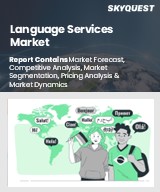
Report ID: SQMIG45A2546
SkyQuest Technology's Language services market size, share and forecast Report is based on the analysis of market data and Industry trends impacting the global Language Services Market and the revenue of top companies operating in it. Market Size Data and Statistics are based on the comprehensive research by our Team of Analysts and Industry experts.
Global Language Services Market size was valued at USD 55.1 billion in 2023 and is poised to grow from USD 58.35 billion in 2024 to USD 92.3 billion by 2032, growing at a CAGR of 5.9% during the forecast period (2025-2032).
What Is Driving the Surge in Global Demand for Language Services?
The global language services market is undergoing a significant transformation, driven by rapid globalization, the proliferation of digital content, and the expanding need for multilingual communication across industries. As businesses increasingly cater to diverse and geographically dispersed audiences, demand for professional translation, localization, interpretation, and language training services is soaring. According to data from the European Union’s Directorate-General for Translation, more than 60% of internet content is still in English, while only about 16% of the global population speaks it. This mismatch is creating substantial opportunities for language service providers to bridge communication gaps and improve global outreach.
How Is Technology Reshaping Language Services?
Technological advancements are acting as a major enabler in this market. AI-powered translation engines, speech recognition software, and cloud-based language platforms are helping service providers increase accuracy, reduce turnaround times, and scale operations. The integration of machine translation with human editing, commonly referred to as “augmented translation,” is gaining traction—particularly in sectors like e-commerce, life sciences, and legal services where accuracy and speed are crucial. However, these technologies also bring a challenge: cost pressures and commoditization, especially for general translation tasks, are impacting the profitability of traditional language agencies.
Why Do Human-Centric Language Services Still Matter?
On the other hand, rising geopolitical tensions, regulatory compliance, and cross-border business expansion continue to drive demand for specialized and certified language services. Industries such as healthcare, law, and government require human expertise for sensitive and culturally nuanced translation, where accuracy is paramount and technology alone cannot suffice. Furthermore, the U.S. Bureau of Labor Statistics projects a 20.2% job growth for interpreters and translators between 2021 and 2031, underscoring the expanding human capital requirements in this sector.
What Are the Key Restraints Holding Back Market Growth?
Nevertheless, market fragmentation, pricing volatility, and the complexity of maintaining linguistic quality at scale remain significant restraints. The lack of standardized pricing models and the presence of numerous small and mid-sized vendors pose operational challenges, especially for large enterprises seeking scalable and consistent language services globally.
How Are Leading Companies Responding to Emerging Needs?
In March 2023, RWS Holdings plc, a UK-based leading language services provider, expanded its AI-enabled translation services through a strategic partnership with Microsoft. This collaboration integrates RWS’s linguistic expertise with Microsoft’s Azure AI platform to enhance automated translation for enterprise clients. The move reflects the growing industry trend of blending human and machine capabilities to deliver scalable, high-quality localization services. Such innovations are increasingly essential as businesses navigate multilingual digital content across sectors like retail, IT, and finance.
REQUEST FOR SAMPLE
Global Language Services Market size was valued at USD 55.1 billion in 2023 and is poised to grow from USD 58.35 billion in 2024 to USD 92.3 billion by 2032, growing at a CAGR of 5.9% during the forecast period (2025-2032).
The global language services market is characterized by intense competition among major players employing diverse strategies to maintain and expand their market share. Companies are increasingly focusing on technological advancements, strategic acquisitions, and global expansion to meet the growing demand for multilingual services across various industries. Leading firms are investing heavily in artificial intelligence and machine learning technologies to enhance service offerings. For instance, RWS Group's Language Weaver, a neural machine translation platform, supports over 50 languages and is integrated into their language services and technology division. This integration enables RWS to provide scalable and efficient translation solutions, catering to clients in regulated industries such as life sciences and legal sectors. 'LanguageLine Solutions Inc. (US)', 'Lionbridge Technologies Inc. (US)', 'RWS Holdings PLC (UK)', 'Iyuno-SDI Group (US)', 'Keywords Studios PLC (Ireland)', 'TransPerfect Translations LLC (US)', 'Honyaku Center Inc. (Japan)', 'Cyracom International Inc. (US)', 'Appen Ltd. (Australia)', 'Acolad Group SAS (France)', 'Amentum (US)', 'Pixelogic Media Partners LLC (US)', 'Translate plus Ltd. (UK)', 'Welocalize Inc. (US)', 'STAR Group (Switzerland)', 'Poletowin Pitcrew Holdings (US)', 'Pactera EDGE (China)', 'AMN Language Services (US)', 'President Translation Service Group International (PTSGI) (US)', 'Voice and Script International (VSI) (US)'
The growing trend of globalization has led to a surge in demand for language services. As companies expand internationally, there is a greater need for translation, localization, and interpretation to facilitate cross-border communication and operations. For instance, in 2024, global e-commerce giants like Amazon and Alibaba heavily invested in multilingual support systems to cater to diverse markets. This trend has boosted the language services market, with translation services expected to grow by over 10% annually in the coming years.
Short-Term: The language services market is experiencing a surge in demand for AI-driven translation tools and NLP technologies. Companies are investing in neural machine translation (NMT) and chatbot solutions to cater to immediate needs for efficiency in industries like e-commerce, healthcare, and finance. Additionally, rising demand for multilingual content in streaming services and e-learning platforms is driving this short-term growth, with companies like TransPerfect expanding their AI services.
What Makes North America the Powerhouse of the Global Language Services Market?
Want to customize this report? This report can be personalized according to your needs. Our analysts and industry experts will work directly with you to understand your requirements and provide you with customized data in a short amount of time. We offer $1000 worth of FREE customization at the time of purchase.
Feedback From Our Clients

Report ID: SQMIG45A2546
sales@skyquestt.com
USA +1 351-333-4748